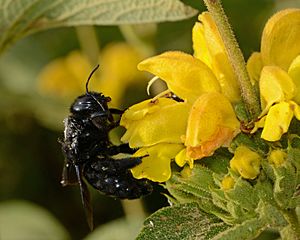Violet carpenter bee facts for kids
Quick facts for kids Violet carpenter bee |
|
|---|---|
 |
|
| Female X. violacea on Phlomis viscosa | |
| Scientific classification | |
| Genus: |
Xylocopa
|
| Species: |
violacea
|
| Synonyms | |
|
|
Xylocopa violacea, also known as the violet carpenter bee, is a large and beautiful bee found across Europe and parts of Asia. It's one of the biggest bees you can find in Europe! Like other carpenter bees, it gets its name because it builds its nests by boring tunnels into dead wood. Don't worry, these bees are usually quite gentle and will only sting if they feel threatened.
Where Do They Live?
The violet carpenter bee lives across Europe and stretches all the way east into central China. They prefer areas above 30 degrees latitude, which means they like warmer, but not tropical, climates.
In recent years, these bees have been expanding their territory. In 2006, they were seen in Wales, and by 2007, they were breeding in England for the first time. This shows they are moving further north, following similar expansions in France, Germany, and the Channel Islands. By 2010, they were also recorded in Northamptonshire and Worcestershire in England.
Life Cycle and Habits
Violet carpenter bees spend the winter months hibernating as adults. They usually hide in old, empty nest tunnels within wood. When spring arrives, typically around April or May, they wake up and become active.
In late spring or early summer, you might see them flying around looking for a partner and a good place to build a new nest. After mating, the female bee starts to bore tunnels into dead wood. This is how they got their "carpenter bee" name! Sometimes, they might even reuse old tunnels.
Like many other solitary bees, the female bee builds her nest all by herself. Inside the tunnels, she creates several small cells. In each cell, she lays an egg and provides a ball of pollen. This pollen ball is food for the larvae (baby bees) when they hatch. The new adult bees emerge in late summer and then hibernate until the next year.
Gallery
-
In Dubai Desert Conservation Reserve, United Arab Emirates
-
In Barcelona
-
In Jardins des Martels, France
-
On a wild thistle in the Cévennes National Park, France
See also
 In Spanish: Abejorro carpintero europeo para niños
In Spanish: Abejorro carpintero europeo para niños









